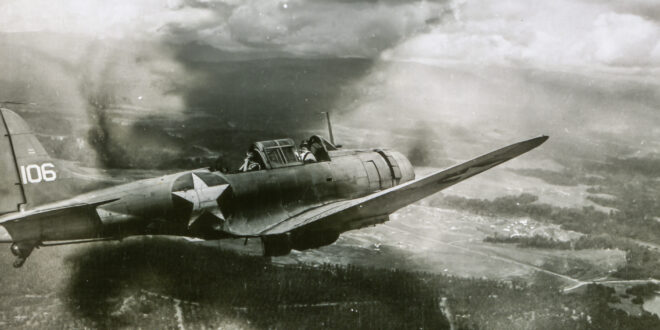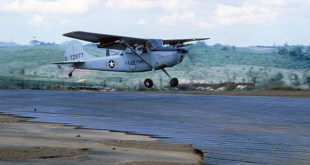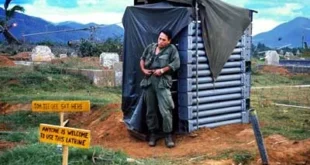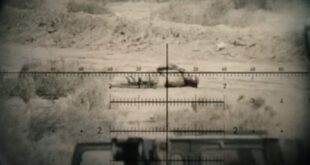by John R. Bruning
A book excerpt from FIFTY-THREE DAYS ON STARVATION ISLAND: The World War II Battle That Saved Marine Corps Aviation.
Henderson Field, Guadalcanal; Friday, August 28, 1942, afternoon
Morning bad weather throughout the Solomons chain scrubbed the Japanese raid against Guadalcanal, a blessed reprieve at a time when men from both squadrons were starting to get sick. Most had developed whatever had knocked Tregaskis off his feet—gastroenteritis. After the reporter had refused to get out of his cot during the previous day’s air raid alert, corpsmen had taken him to the local medical tent, where he stayed throughout the twenty-eighth.
The aviators and ground crew afflicted by the same virus fell out with vomiting and diarrhea. In the heat and humidity of Guadalcanal, they quickly became dehydrated, which made them weak and listless. With the Marines already shorthanded, any illness spreading through the ranks threatened to reduce the squadrons to skeleton crews.
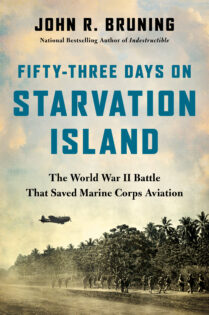
Dick Mangrum could not afford to lose any of his aircrew to disease. He had twelve pilots and gunners and nine planes, all currently overtasked.
Dick also loved building structures and systems. He was a methodical thinker and had been this way since his youth, when he’d been an honors student at Franklin High School in Seattle. His father worked as a carpenter and contractor. From him, Dick had inherited the vision and ability to manage the creation of something complex, like a building.
In school, Dick had not been a spectacular athlete. Second string on both the football and the basketball junior varsity squads. Instead, he was the architect behind the scenes and out of the limelight, making sure things ran smoothly. He’d been the manager for the track team, where his meticulous attention to detail shone. Same with the school plays and operettas, where he never performed onstage but coordinated all the ushers.
On Guadalcanal, with Lt. Col. Charles Fike’s input and blessing, Dick Mangrum built the search-and-strike system that both 232 and Flight 300 used. Each squadron dedicated part of its available pilots and planes to the two searches a day. The first search would go out before dawn, looking for any ships either running up the Solomons after debarking troops at night or coming down in daylight as had happened on August 25. A late afternoon search would seek incoming Japanese task forces intent on unloading under the cover of darkness. Each crew had orders to go out to 250 miles.
Meanwhile, Dick kept a reserve strike force sitting on the runway at Henderson, armed with thousand-pound bombs and capable of taking off to hit a target within minutes. Because these aircraft would also have to be cleared off the field if there was a Japanese air raid, the ground crews had to refuel and service them every afternoon after those scrambles.
Every aircraft was dedicated to one or the other role; there was no ready reserve. With only three extra crews for the nine SBDs, some of the men would have to fly every day.
This strike and search system was fine with Henry Hise, whose first week on Guadalcanal proved the axiom that in a crisis, the best characters emerge. He volunteered for every flight, every mission. He was up for anything and wanted to fight. He thirsted for it. Mangrum knew to be careful not to burn out his hard charger. In the meantime, the skipper gave Hise a long leash to get out and get in the air often.
On August 28, Henry flew both the morning search and the afternoon one. In the first days after 232 had arrived, the squadron had been able to commit only a few planes for a token search. With Flight 300 helping out, Mangrum could afford to be more thorough. On the runway that day, his strike element consisted of four SBDs from 232 (Mangrum, Tom Moore, Oliver Mitchell, and Don Rose) plus another five from Flight 300. The afternoon search element started taking off around 1400 and consisted of two Flight 300 SBDs and five more, piloted by Danny Iverson, Henry Hise, Don McCafferty, Fletcher Brown, and Bruce Prosser. With seven SBDs, the group could fan out from the Russell Islands in the northwest across Santa Isabel and all the way to the north beyond Ramos Island near where they had destroyed the August 25 convoy.
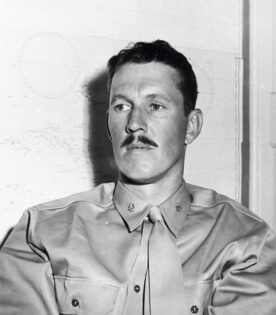
LTC Richard “Dick” Mangrum. He commanded dive-bomber squadron VMSB-232 on Guadalcanal, the first offensive air power to reach the island. Credit: Author’s Collection
Iverson and Hise flew the left flank of the pie, running up toward the Russells along the west side of the New Georgia Sound, called the Slot, the long body of water between islands in the Solomon chain. The two Flight 300 crews and McCafferty, Prosser, and Brown flew the middle and northernmost wedges of the search fan, spread out across the Slot almost due north up between Santa Isabel and Malaita.
About two hours into the mission, Don McCafferty heard a distant voice in his radio headphones reporting four large Japanese destroyers heading south for Guadalcanal. The voice gave their position, and Don pulled out his kneeboard to plot it on his map. They were close, somewhere behind and north of him. The scattered layers of clouds must have shielded them from his view when he passed them.
“Here We Go”
The voice, probably Brownie’s, ordered everyone to converge on the target and sink those ships. Don turned to the northeast. In only a few minutes, he spied them through a break in the clouds: four dots riding the horizon. The sun hung low in the west, dusk only about ninety minutes away now. Still, attacking from upsun would help shield his SBD from the Japanese. He positioned himself just as Dick Mangrum had taught the aviators, then called to his gunner, Lewis Macias, “Here we go.”
A wingover and steep dive later, his nose was pointed right at a twisting, turning destroyer busily working up to flank speed. Don stayed on the vessel, passing through a thousand feet before pushing the bomb release lever. His bomb swung clear of the propeller arc and speared down at his target. As he pulled out on the wave tops, Lewis called out, “You laid that one right off his beam, Lieutenant. Gee, but this is fun.”
Don stayed low and pulled out of antiaircraft range. As he did, he heard Danny Iverson’s genteel Southern accent call over the radio, asking if the ships were friend or foe. The atmospherics in the Solomons were terrible, and radio communications frequently failed, especially with the frequencies the SBDs used. Don assumed Danny hadn’t heard the initial contact report or the order to converge on the target and sink it. He checked his gas situation and found he had plenty left, especially since they were only about sixty miles from home. He decided to climb back up, turn around, and keep an eye on the task force while reporting their movements over the radio.
As Don found a good cloud to loiter in, outside antiaircraft range, Danny Iverson dropped through the scud and ordered his gunner to flash a recognition signal at the ships below to confirm if they were friendly or not. They replied by sending a barrage of flak up their way. Most certainly not friendly. Danny pulled back up into the clouds and reunited with Hise. They flew on for a minute or two longer when, without warning, Danny suddenly rolled up and over into a steep dive through a hole in the clouds. Hise hastily followed. It was a fouled-up run from the get-go. The bad weather made it even harder to stay on the targets while the ships maneuvered furiously. Plus, the dive was quick and not well planned. Danny never got properly lined up and abandoned his run without dropping his bomb. Hise did the dive-bomber equivalent of a spray and pray—launching his weapon at twenty-five hundred feet. The only things he killed were fish.
Furious that he’d blown the run, Hise raced back to Henderson Field with Danny. Both Brownie and Bruce attacked the ships and also raced home while the two Flight 300 crews made attacks of their own. Ens. J. T. “Dog” Barker thought he’d scored a hit on the fantail of the trail destroyer.
Around 1645, Henry blazed over Henderson, made a quick circuit as he dropped gear and flaps, and then planted his SBD on the runway. Instead of taxiing to the parking area, he drove his dive-bomber straight to the Pagoda to save time. He cut the switches, jumped out, and ran inside to report the contact while his gunner busily went after the ground crew to get their aircraft refueled and rearmed.
No Radio System
Henderson Field did not have a radio system that could communicate with the search planes beyond twenty or thirty miles, so Mangrum hadn’t heard the contact reports or Don McCafferty’s ongoing commentaryon their position. He quickly plotted the ships’ locations, briefed the crews, and headed out to get their birds off the ground. Flight 300’s strike element was parked closest to the runway and would take off first, led by their commander, Lt. Turner Caldwell. Mangrum decided to give Brownie and Hise enough time to get their planes rearmed with a bit of extra fuel for the mission. Since they were only seventy miles from Henderson, they wouldn’t need to waste time filling all their fuel tanks.
Over at Vandegrift’s headquarters, Bob Miller, one of the only other reporters on the island, sat beside one of the most treasured captures of the campaign, a Japanese radio set that could hear the SBDs quite clearly. The division staff clustered around the radio, listening to the 232 crew’s chatter. For whatever reason, the initial contact reports had not been passed to the flight line and the waiting strike force. The delay ensured that Mangrum’s men would go in right at sunset and wouldn’t have time for a second strike.
Four large destroyers could carry a significant number of troops—150 to 200— plus heavy weapons like anti-guns or light artillery, and around 30 to 40 tons of supplies. If the Japanese reached the island, this taskforce would put ashore at least 600 fresh troops and up to 160 tons of ammo, food, medical gear, and so forth. That amount of men and material presented a significant threat to the Marine perimeter.
The Navy’s Dauntlesses rose off the gravel runway first, forming up as they flew north with thousand-pound bombs on their centerline racks. It took about twenty extra minutes to get Henry and Brownie ready to fly. Bruce Prosser and Danny Iverson were out. Henry had already flown two missions that day, spending over seven hours in the air, but he wasn’t feeling it. He wanted a second crack at this Japanese task force and wasn’t about to be left behind. Brownie felt the same way. The executive officer had missed the attack on August 25. This was his chance to make up for that.
Second Lieutenant Don Rose also missed the action on the twenty-fifth, as he was assigned to patrol duties. Mangrum liked this young Minnesotan, who at five feet ten and 150 pounds was one of the taller pilots in the squadron. He was an earnest and intense farm kid from the tiny town of Lanesboro, where he’d been the valedictorian of his high school class. He’d graduated with honors from St. Olaf College before enlisting in the Navy in April 1941.
Shortly after arriving at Henderson, Rose discovered that Angsar South, one of his favorite professors at St. Olaf, was serving as a chaplain in the 1st Marine Division. The two shared a what-a-small-world reunion and stayed in contact whenever they could around missions and duties.
Sometime after 1730 on August 28, Mangrum’s little force went wheels up and feet wet over Savo Sound, rushing north as they climbed to attack altitude through the scattered clouds. Dick led the way, with Tom Moore, Don Rose, Fletcher Brown, Henry Hise, and the butcher’s son, Oliver Mitchell, fanned out in line abreast on either side of him.
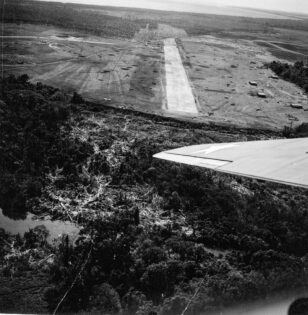
Henderson Field, Guadalcanal as seen from one of Dick Mangrum’s SBDs on August 22, 1942, the first day of light operations for VMF-223 and VMSB-232. Credit: National Archives.
Caldwell didn’t wait for Mangrum’s six planes. His five were many miles in front of the Marines and off their starboard wings. They would reach the enemy first and make their attacks without Dick’s group. Though going in piecemeal was far from optimal, having daylight overrode any other consideration.
Meanwhile, Don McCafferty continued to duck in and out of the clouds near the Japanese ships, reporting that they had turned north away from Guadalcanal. Dick was able to talk to him as they closed on the target area. “Okay, Don, we’re going in where you left off.”
Don had been loitering for over half an hour. It was time to get his bird on the ground. He swung his nose south and headed for Henderson as the two small strike groups reached the target area.
Sure enough, Caldwell’s bombers rolled into the attack first, coming in from the east. Dropping down between the clouds, Caldwell scored a near miss on one of the destroyers while Ens. Chris Fink dropped his bomb dead amidships on another, the thousand-pounder landing directly atop one of the ship’s torpedo mounts. The bomb touched off the torpedoes and created a massive explosion that blew the destroyer in half. Hal Buell, a veteran of all three 1942 carrier battles, dove fourth out of the five Flight 300 aircraft. He blew through a cloud and, from less than two thousand feet, released his weapon on a hard-turning destroyer. His gunner reported that their bomb struck almost amidships, but they had no time to stick around and observe. The two trailing destroyers opened on them with rapid-fire 25 mm guns, spraying the sky around them with tracers. Buell hugged the water and raced for home.
As the Marines closed from the southwest, Dick called out, “Four ships sighted, fifteen miles north of Ramos Island. One seems to be afire.”
The radio remained silent for a couple of minutes as Dick worked them into attack position. The sun sagged right on the water, casting the ships in twilight-gray shadows. Between the clouds and the gathering darkness, they were hard to see now.
Dick watched the ships below, their antiaircraft guns striping the sky as dozens of muzzle flashes illuminated their decks. Though the flak remained a serious threat, the fact that they were firing gave the Marines an unexpected advantage. As long as the Japanese kept shooting like that, his pilots would have well-defined aiming points, thanks to those muzzle flashes.
Just follow the tracers back to their sources.
One of the destroyers completed a 360-degree turn, inscribing a lopsided white circle in the calm sea with its wake. Another destroyer had snaked past it, its wake carving an S. There seemed to be no base course for the remaining ships anymore. One appeared dead in the water. Another was little more than a bit of bow and stern protruding from the waves with a rash of debris and fire in between. The remaining two maneuvered radically, sending up shocking amounts of flak at the SBDs.
About ten thousand feet over the Japanese ships, Dick keyed his mic and assigned targets to his men. The Japanese suddenly found the range, and bursting red-black puffs of high-explosive shells scarred the air around them. Were these five-inch blasts from their main batteries? The Marines didn’t know, but they threw the Dauntlesses around with violent fury.
In the open gunner’s cockpit of Dick’s SBD, Dennis Byrd could smell the cordite and gunpowder from the nearest bursts. The stench reminded him of the fireworks he used to set off as a kid in Texas during the Fourth of July. A fond memory, one that contrasted sharply with the terror of the moment. The flak seemed to inch closer and closer to their SBDs and Dennis wondered how any of them flew through it and survived. Concussive waves from the exploding shells buffeted their aircraft, and shrapnel whirred through their formation.
Mangrum’s voice broke the static back at Vandegrift’s HQ, where the staff and Miller heard him say, “We’ll rendezvous after the attack.”
Dick chopped his throttle, popped his dive flaps, and pushed his stick forward. The Dauntless’s nose dropped into a seventy-degree dive from ten thousand feet. Tracers streamed by. Flak burst above and behind their bomber now. The sun was gone, the water nothing but a sheet of blackness on which the destroyers glowed red-orange as all their guns blazed away at 232’s Dauntlesses, which had dived at one-second intervals after their skipper.
Dick’s target turned hard to port, its wake broad and long, signaling it was doing probably thirty knots or better. The destroyer skittered out of his gunsight, forcing him to roll left. He passed eight thousand feet now, clouds zipping by on either side of the aircraft. Suddenly, the destroyer heeled over and turned sharply to starboard, throwing Dick’s aim off again. The skipper rolled hard right to get back on target. Dennis looked up and realized they were inverted now, the destroyer and black sheet of ocean stretched over his head.
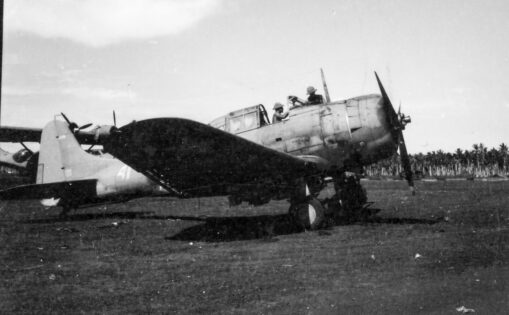
One of VMSB-232’s battered SBDs being readied for another mission at Henderson Field. Credit: National Archives.
Fireballs of Flak
The terrifying dive continued as fireballs of flak lit the night and shook their plummeting SBD. Dick worked back onto the target and released while pulling through the dive. They leveled off at less than a hundred feet, racing past the broken, sinking bow of the destroyer Ensign Fink had blown up.
Tom Moore was probably the second Marine to dive that evening, following his skipper down through the rising tide of antiaircraft fire. He muffed the run and, on pullout, heard his gunner say laconically, “Miss.”
Don Rose went in after Tom did, the wind shrieking like a siren through his butterfly flaps. Again, the destroyer skippers proved canny and skilled. His target twisted out of the way, and Don’s bomb scored only a near miss.
Brownie went next, closely followed by Oliver and then Henry, who had forgotten to shift his supercharger to high blower and was lagging behind. Brownie thought he scored a hit and pulled out just above the surface, which he could see was strewn with flaming debris and bodies. He sped after Dick’s SBD, which was just visible as a black silhouette in the distance with a blue exhaust flame streaming back from the cowling on either side of its fuselage.
Henry thought he’d executed a perfect dive. He had that sense he used to get when staring down a pitcher on a baseball diamond. That instinct told him his swing was going to connect. He led his target, held the bomb until he passed well below fifteen hundred feet, then cut it loose. By the time he’d closed his flaps and pulled out so low that his own tail wheel left a bright wake in the water, his gunner reported their bomb had exploded just forward of the destroyer’s bow. Another goddamned miss.
As Henry made his attack, Dennis Byrd and the other gunners saw Oliver Mitchell’s SBD arrow straight after one of the remaining ships. The destroyer flung a wall of flak up at Oliver’s diving Dauntless, but that didn’t deter him. Oliver Mitchell stayed on target, his forward guns spraying long ropes of tracers as he dove, strafing the destroyer in a desperate bid to kill the gunners shooting at him. At the last possible second, he dropped his bomb.
Oliver’s SBD went straight into the water. Dennis Byrd saw it impact the water’s surface and vanish in the darkness.
Excerpted from FIFTY-THREE DAYS ON STARVATION ISLAND: The World War II Battle That Saved Marine Corps Aviation. Available from Hachette Books. Copyright @2024 by John R. Bruning and reprinted with permission from Hachette Books/Hachette Book Group. All rights reserved.
 Soldier of Fortune Magazine The Journal of Professional Adventurers
Soldier of Fortune Magazine The Journal of Professional Adventurers


